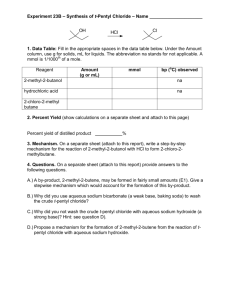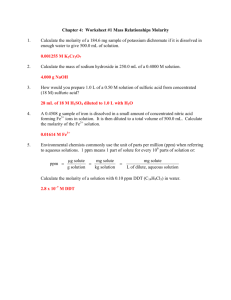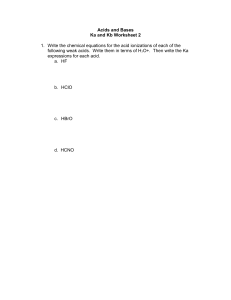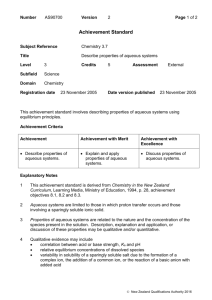AP Chemistry Practice Test: Chapter 4
advertisement
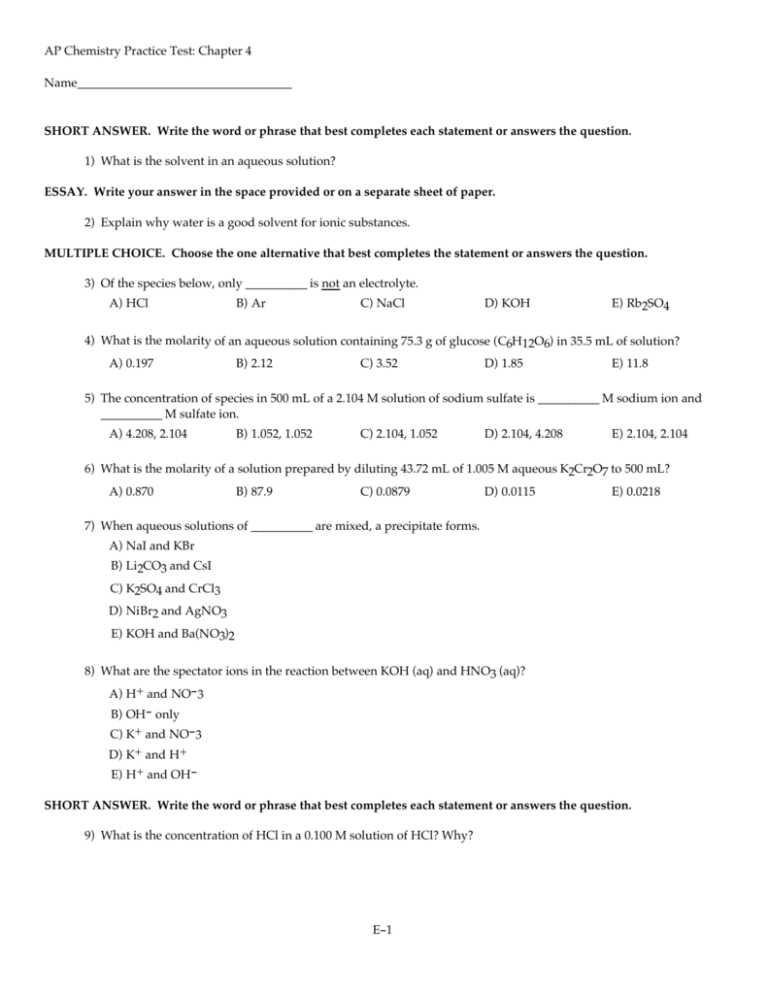
AP Chemistry Practice Test: Chapter 4 Name___________________________________ SHORT ANSWER. Write the word or phrase that best completes each statement or answers the question. 1) What is the solvent in an aqueous solution? ESSAY. Write your answer in the space provided or on a separate sheet of paper. 2) Explain why water is a good solvent for ionic substances. MULTIPLE CHOICE. Choose the one alternative that best completes the statement or answers the question. 3) Of the species below, only __________ is not an electrolyte. A) HCl B) Ar C) NaCl D) KOH E) Rb2SO4 4) What is the molarity of an aqueous solution containing 75.3 g of glucose (C6H12O6) in 35.5 mL of solution? A) 0.197 B) 2.12 C) 3.52 D) 1.85 E) 11.8 5) The concentration of species in 500 mL of a 2.104 M solution of sodium sulfate is __________ M sodium ion and __________ M sulfate ion. A) 4.208, 2.104 B) 1.052, 1.052 C) 2.104, 1.052 D) 2.104, 4.208 E) 2.104, 2.104 6) What is the molarity of a solution prepared by diluting 43.72 mL of 1.005 M aqueous K2Cr2O7 to 500 mL? A) 0.870 B) 87.9 C) 0.0879 D) 0.0115 E) 0.0218 7) When aqueous solutions of __________ are mixed, a precipitate forms. A) NaI and KBr B) Li2CO3 and CsI C) K2SO4 and CrCl3 D) NiBr2 and AgNO3 E) KOH and Ba(NO3)2 8) What are the spectator ions in the reaction between KOH (aq) and HNO3 (aq)? A) H+ and NO- 3 B) OH- only C) K+ and NO- 3 D) K+ and H+ E) H+ and OHSHORT ANSWER. Write the word or phrase that best completes each statement or answers the question. 9) What is the concentration of HCl in a 0.100 M solution of HCl? Why? E-1 MULTIPLE CHOICE. Choose the one alternative that best completes the statement or answers the question. 10) Lead ions can be precipitated from aqueous solutions by the addition of aqueous iodide: Pb2+ (aq) + 2I- (aq) ¬ PbI2 (s) Lead iodide is virtually insoluble in water so that the reaction appears to go to completion. How many milliliters of 3.550 M H I(aq) must be added to a solution containing 0.400 mol of Pb(NO3) (aq) to completely 2 precipitate the lead? A) 113 B) 225 C) 4.44 ˛ 10-3 D) 0.113 E) 0.225 11) A 31.5 mL aliquot of H2SO4 (aq) of unknown concentration was titrated with 0.0134 M NaOH (aq). It took 23.9 mL of the base to reach the endpoint of the titration. What was the concentration (M) of the acid? A) 0.0102 B) 0.0051 C) 0.0204 D) 0.227 E) 0.102 12) The balanced half-reaction in which dichromate ion is reduced to chromium metal is a __________ process. A) two-electron B) six-electron C) four-electron D) twelve-electron E) three-electron 13) What is the molarity (M) of an aqueous solution containing 22.5 g of sucrose (C12H22O11) in 35.5 mL of solution? A) 3.52 B) 1.85 x 10-3 C) 0.104 D) 0.0657 E) 1.85 14) Pure acetic acid (HC2H3O2) is a liquid and is known as glacial acetic acid. Calculate the molarity of a solution prepared by dissolving 15.00 mL of glacial acetic acid at 25eC in sufficient water to give 500.0 mL of solution. The density of glacial acetic acid at 25e C is 1.049 g/mL. A) 1.89 ˛ 103 B) 31.5 C) 0.525 D) 5.25 ˛ 10-4 E) 0.0315 15) Which one of the following compounds is insoluble in water? A) Ag2CO3 B) K2SO4 C) ZnS D) Na2CO3 16) With which of the following will ammonium ion form an insoluble salt? A) chloride B) sulfate C) sulfate and carbonate D) carbonate E) none of the above E-2 E) Fe(NO3)3 17) Combining aqueous solutions of BaI2 and K2SO4 affords a precipitate of BaSO4. Which ion(s) is/are spectator ions in the reaction? A) Ba2+ only B) K+ and IC) SO42- and ID) Ba2+ and SO42E) K+ only 18) A 25.5 mL aliquot of HCl (aq) of unknown concentration was titrated with 0.113 M NaOH (aq). It took 51.2 mL of the base to reach the endpoint of the titration. What was the concentration (M) of the acid? A) 0.454 B) 0.113 C) 1.02 D) 0.114 E) 0.227 19) __________ electrons appear in the following half-reaction when it is balanced. S4O62- ¬ 2S2O32A) 4 B) 1 C) 2 D) 6 E) 3 20) What is the coefficient of the bromide ion when the following redox equation is balanced? BrO- + Fe(OH)2 ¬ Br- + Fe(OH)3 A) 4 B) 5 (basic solution) C) 2 D) 1 E) 3 21) What mass (g) of potassium chloride is contained in 430 mL of a potassium chloride solution that has a chloride ion concentration of 0.193 M? A) 0.0643 B) 0.386 C) 6.19 D) 12.37 E) 0.0830 22) What is the molarity (M) of an aqueous solution containing 22.5 g of glucose (C6H12O6) in 35.5 mL of solution? A) 0.197 B) 0.634 C) 1.85 D) 0.125 E) 3.52 23) Which one of the following is a correct expression for molarity? A) mmol solute/mL solution B) mol solute/mL solvent C) mol solute/L solvent D) mmol solute/L solution E) mol solute/kg solvent 24) What is the concentration of chloride ions in a 0.193 M solution of potassium chloride? A) 0.193 M B) 0.0643 M C) 0.579 M D) 0.386 M E) 0.0965 M 25) A stock solution of HNO3 is prepared and found to contain 14.2 M of HNO3. If 25.0 mL of the stock solution is diluted to a final volume of 0.500 L, the concentration of the diluted solution is ________ M. A) 0.284 B) 284 C) 0.710 E-3 D) 710 E) 1.41 Answer Key Testname: CH_04_PRAC_TEST.TST SHORT ANSWER. Write the word or phrase that best completes each statement or answers the question. 1) water ID: chem9b 4.1-1 ESSAY. Write your answer in the space provided or on a separate sheet of paper. 2) The oxygen of water has a slight negative charge that is attracted to and surrounds the cation of the ionic substance, stabilizing it in solution. The hydrogens of water have a slight positive charge and thus are attracted to and surround the anion of the ionic substance stabilizing it in solution. ID: chem9b 4.1-2 MULTIPLE CHOICE. Choose the one alternative that best completes the statement or answers the question. 3) B ID: chem9b 4.1-3 4) E ID: chem9b 4.1-107 5) A ID: chem9b 4.1-118 6) C ID: chem9b 4.1-112 7) D ID: chem9b 4.1-24 8) C ID: chem9b 4.1-10 SHORT ANSWER. Write the word or phrase that best completes each statement or answers the question. 9) Essentially zero because HCl is a strong electrolyte and will be virtually completely ionized in solution leaving no intact HCl molecules. ID: chem9b 4.1-4 MULTIPLE CHOICE. Choose the one alternative that best completes the statement or answers the question. 10) B ID: chem9b 4.2-8 11) B ID: chem9b 4.1-135 12) D ID: chem9b 20.1-21 13) E ID: chem9b 4.1-104 14) C ID: chem9b 4.2-3 15) C ID: chem9b 4.1-25 16) E ID: chem9b 4.1-30 17) B ID: chem9b 4.1-12 E-1 Answer Key Testname: CH_04_PRAC_TEST.TST 18) E ID: chem9b 4.1-133 19) C ID: chem9b 20.1-14 20) D ID: chem9b 20.1-15 21) C ID: chem9b 4.1-115 22) E ID: chem9b 4.1-106 23) A ID: chem9b 4.1-78 24) A ID: chem9b 4.1-114 25) C ID: chem9b 4.2-2 E-2
